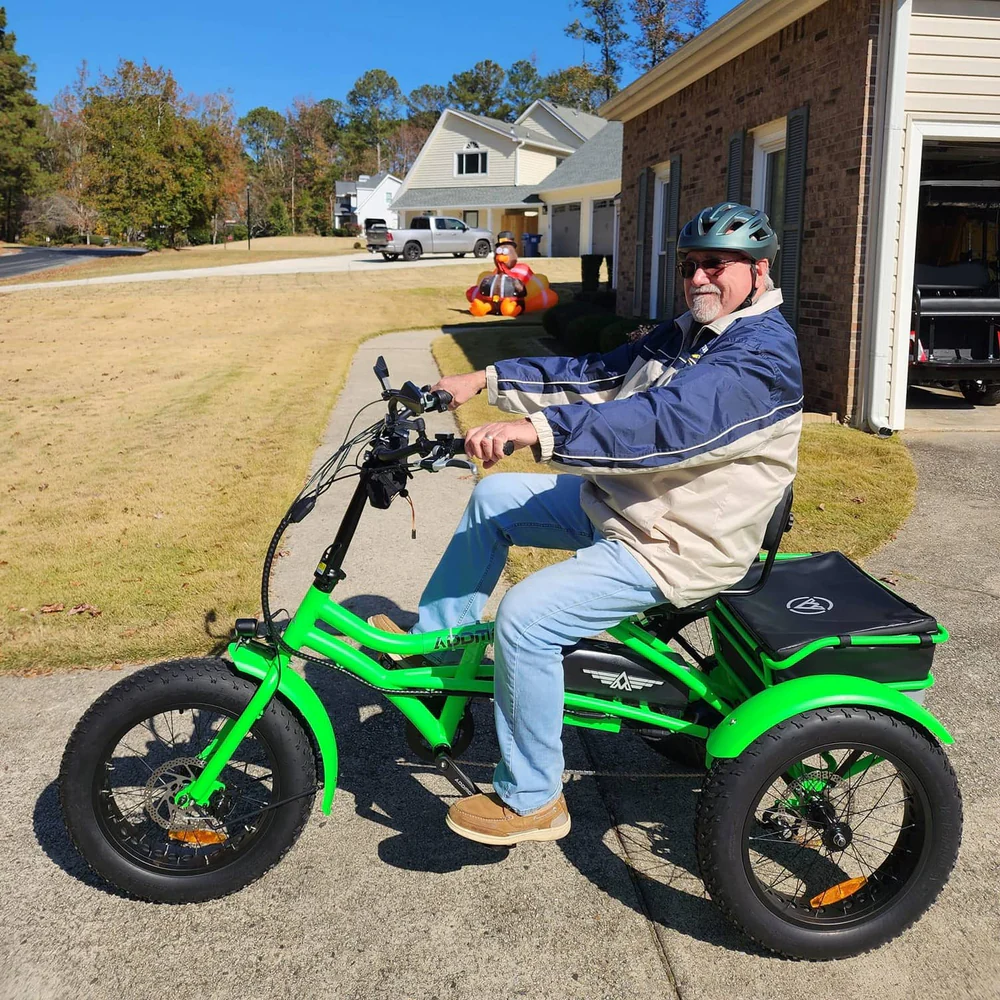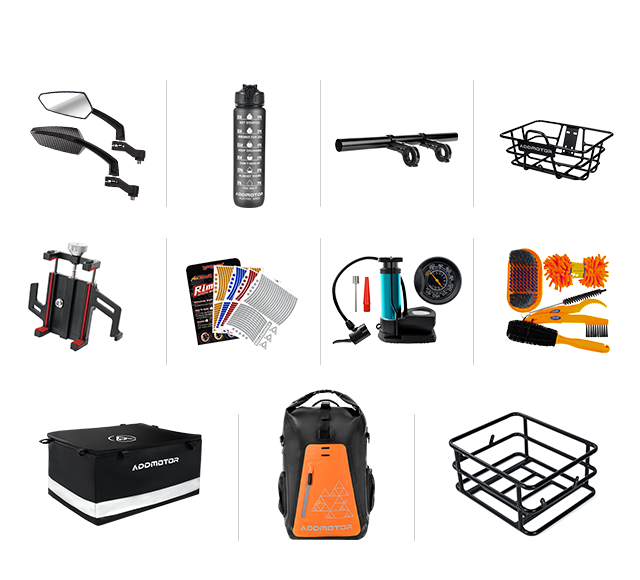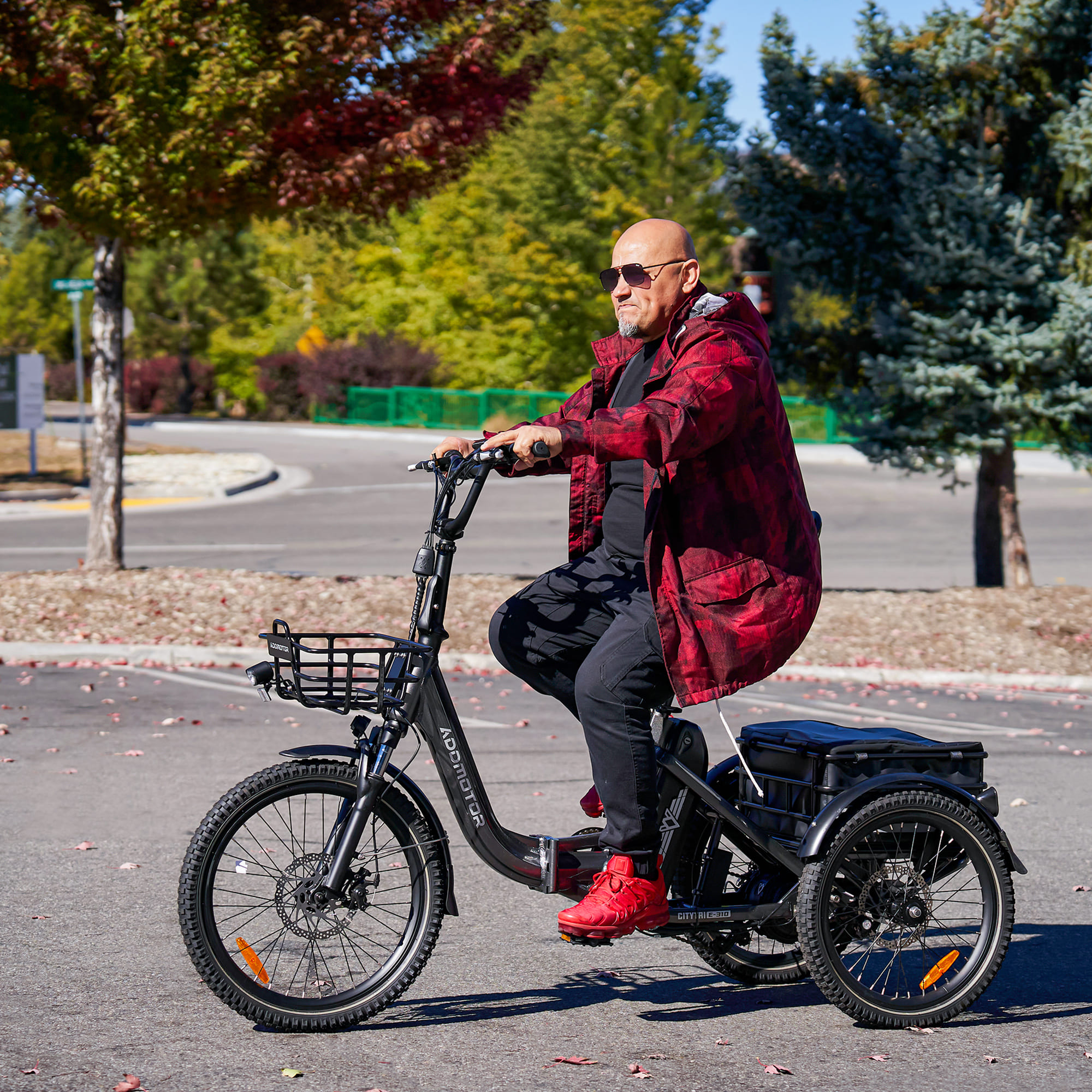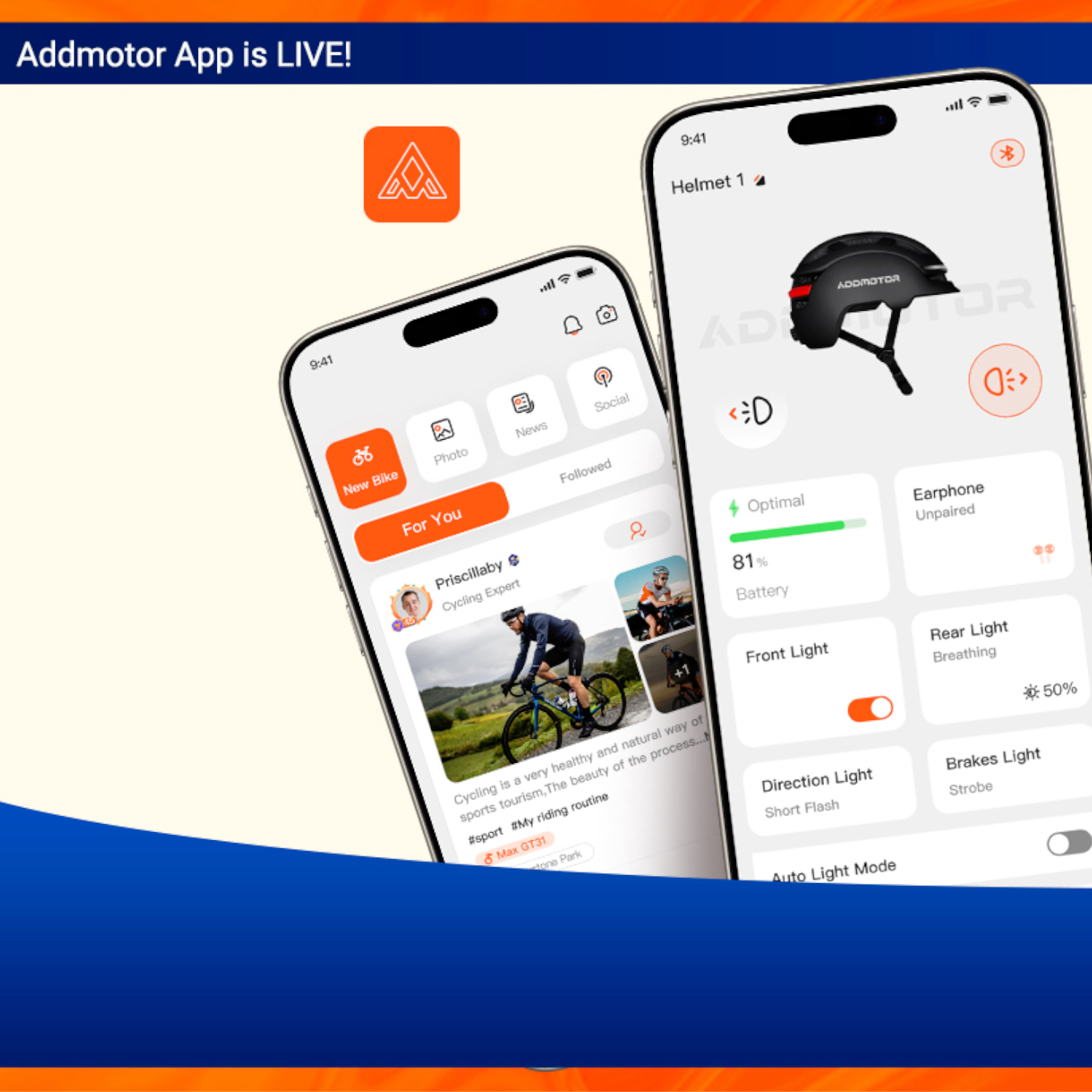Find the Best Electric Bike for Yourself | Addmotor Guide
_1682303642.jpg)
Imagine gliding effortlessly through bustling city streets, conquering rugged mountain trails with ease, or cruising along serene beachside paths with the wind in your hair. Now, picture doing all of this on a cutting-edge and environmentally-friendly mode of transportation that combines the best of pedal power and electric motor technology. Welcome to the extraordinary world of electric bikes, where the possibilities are limitless, and the thrill is unmatched.
In this article, we will embark on an electrifying journey to help you find the best electric bike that suits your unique needs and style. From futuristic features to terrain-tackling capabilities, motor types to brake systems, class distinctions to sensor technologies, and frame designs to riding styles, we will explore every aspect of electric bikes to guide you toward making an informed decision.
Get ready to be captivated by the awe-inspiring world of electric biking, where innovation meets adventure, and the ride of a lifetime awaits you! So, strap on your helmet, charge up your excitement, and let's embark on an electrifying quest to find your perfect electric bike companion that will leave you craving more!
- Consider Your Riding Intentions
- Evaluate Your Riding Terrain with E-Bike
- Focus on Electric Bike Key Features
- Consider Your Height
- More Details about Electric Bike
- Two-Wheeler or Three-Wheel Electric Bike
- Thin or Fat Tire E-Bike
- Front, Mid-Drive, or Rear Motor
- Mechanical Disc Brakes or Hydraulic Disc Brakes
- Class 1, 2, or 3 Electric Bike
- Pedal Assist Cadence Sensor vs. Torque Sensor
- Step-Over E-Bikes vs. Step-Through Electric Bikes
- Types of Electric Bikes
- Conclusion
#1 Consider Your Riding Intentions
When looking for the best electric bike, it is crucial to consider your riding intentions. Think about how you plan to use the electric bike. Are you using it for daily commuting to work or school? Are you looking for a bike to run errands and do grocery shopping? Or are you seeking a leisurely ride for recreational purposes? Understanding your riding intentions will help you choose an electric bike that meets your specific needs.
For instance, if you require a bike for daily commuting, a city electric bike with a comfortable upright riding position, fenders, and lights may be ideal. If you plan to do grocery runs, an electric cargo bike with a sturdy rack or panniers for carrying loads may be the best choice. On the other hand, if you are looking for a bike for leisurely rides, a beach cruiser electric bike with a relaxed riding position and stylish design may be a perfect fit.
#2 Evaluate Your Riding Terrain with E-Bike
The type of terrain you ride on more frequently is another crucial factor in finding the best electric bike for you. Consider the surfaces you'll be riding on - whether it is mostly flat roads, paved paths, gravel trails, or rugged mountain trails. Different electric bikes are designed for different terrains. For smooth surfaces, a city electric bike with thinner tires and a lightweight frame may provide a comfortable and efficient ride.
Also, if you plan to venture off-road, an all-terrain electric bike with wider tires, robust suspension forks, and a more durable frame may be better suited for rough terrains. Similarly, if you live in an area with sandy beaches or loose surfaces, a fat tire electric tricycle with wide, grippy tires can provide enhanced stability and traction.
More Details: Different Types Of Electric Bikes
#3 Focus on Electric Bike Key Features
The features of an electric bike can significantly impact your riding experience. When choosing an electric bike, it is crucial to consider the key feature that aligns with your preferences and riding style. Understanding and evaluating these key features can help you make an informed decision and find the best electric bike that meets your specific needs and requirements.
1. Motor- The motor is the heart of an electric bike, and it determines how much assistance you will get while pedaling. There are three main types of motors: front, mid-drive, and rear. Front motors are typically less expensive and provide basic assistance, while mid-drive motors offer better torque for hill climbing and rear motors provide a more natural biking experience.
2. Battery- The battery is responsible for powering the motor and determining the range of your electric bike. Consider the battery capacity (measured in watt-hours), the type of battery (such as lithium-ion or lithium-polymer), and the location of the battery on the bike (frame-mounted or rear rack-mounted).
3. Electric Assist Modes- Electric bikes usually come with different levels of electric assist modes, such as pedal-assist and throttle. Pedal-assist modes provide assistance based on your pedaling, while throttle allows you to control the motor with a twist or push of a button. Consider the number of assist levels, the ease of switching between modes, and the range of assistance provided.
More Details: Pedal Assist System (PAS) Explanation
4. Frame Design- The frame design of an electric bike can affect its stability, comfort, and ease of use. Consider factors such as step-over or step-through frame, frame material (such as aluminum or steel), and geometry (such as upright or sporty) based on your preference and intended use.
5. Additional Features- Consider other additional features, such as lights, fenders, racks, suspension forks, and gears based on your needs and preferences. These features can enhance the comfort, convenience, and versatility of your electric bike.
It is important to consider these key features based on your riding style, preferences, and intended use of the electric bike. Prioritize the features that are most important to you and align with your specific needs to find the best electric bike that fits your requirements and enhances your overall biking experience.
#4 Consider Your Height
Your height is an important factor to consider when choosing an electric bike. The right frame size can greatly impact your comfort and riding experience. It is essential to choose a frame size that allows for proper leg extension while pedaling and provides a comfortable riding position. Generally, electric bikes come in different frame sizes, ranging from small to extra-large, to accommodate riders of varying heights.
If you are taller, you may require a larger frame size with a higher top tube and longer top tube length to ensure a comfortable riding posture and optimal performance. On the other hand, if you are shorter, a smaller frame size with a lower top tube and shorter top tube length may be more suitable. It is recommended to test ride different frame sizes and styles to determine the one that fits you best.
Consider your height when choosing an electric bike to ensure that you can ride comfortably and efficiently, avoiding any discomfort or strain during your rides. A properly sized frame can greatly enhance your overall riding experience and allow you to fully enjoy the benefits of electric biking.
#5 More Details about Electric Bike
When choosing an electric bike, there are several other important considerations to keep in mind, apart from the type of terrain, features, and rider height. These considerations include:
1. Two-Wheeler or Three-Wheel Electric Bike-
Electric bikes are available in two-wheel and three-wheel configurations, each with its advantages. Two-wheel electric bikes are similar to traditional bicycles and offer a more familiar riding experience. They are ideal for riders who are comfortable balancing and maneuvering on two wheels.
On the other hand, three-wheel electric bikes provide additional stability and balance, making them suitable for riders who may have difficulty with balance or stability, such as elderly or disabled riders. Three-wheel electric bikes are also ideal for carrying cargo or for those who prefer a more leisurely and comfortable ride with added stability.
2. Thin or Fat Tire E-Bike-
Electric bikes come in different tire sizes, including thin and fat tires. Thin tire electric bike are suitable for smoother roads and pavement, providing a more traditional biking experience with less rolling resistance. They are ideal for urban commuting or recreational riding on well-paved roads. But also there are some cons of thin tires, you may click to know more.
On the other hand, fat tires are wider and designed for off-road adventures, providing enhanced traction and stability on rugged terrains, such as sand, snow, or dirt trails. Fat tire e-bikes are perfect for riders who enjoy exploring off-road trails or want a more versatile option that can handle various terrains.
3. Front, Mid-Drive, or Rear Motor-
The location of the motor on an electric bike can greatly impact its performance and handling. Electric bikes can have motors located in different positions, including the front, mid-drive, or rear.
· Front motors are typically less expensive and provide additional power for flat terrains, making them suitable for riders who need assistance on mostly flat terrains or for urban commuting.
· Mid-drive motors, on the other hand, offer better torque and performance on steep hills and challenging terrains. They provide assistance based on the rider's pedaling cadence and gear selection, making them more efficient and suitable for off-road or hilly terrain riding.
· Rear motors provide a more traditional biking experience and are ideal for leisurely rides or urban commuting on flat terrains.
4. Mechanical Disc Brakes or Hydraulic Disc Brakes-
Brakes are a critical safety feature on electric bikes, and there are different types of brakes available, including mechanical disc brakes and hydraulic disc brakes. Mechanical disc brakes are generally more affordable and easier to maintain, making them suitable for riders on a budget or those who prefer simpler maintenance. They provide sufficient stopping power for most riding conditions.
On the other hand, hydraulic disc brakes offer more precise and powerful braking performance, making them ideal for riders who demand higher braking performance, such as off-road riders, or those who ride at higher speeds. Hydraulic disc brakes are known for their consistent and reliable stopping power, making them suitable for riders who prioritize safety and performance.
5. Class 1, 2, or 3 Electric Bike-
Electric bikes are categorized into different classes based on their maximum speed and level of assistance.
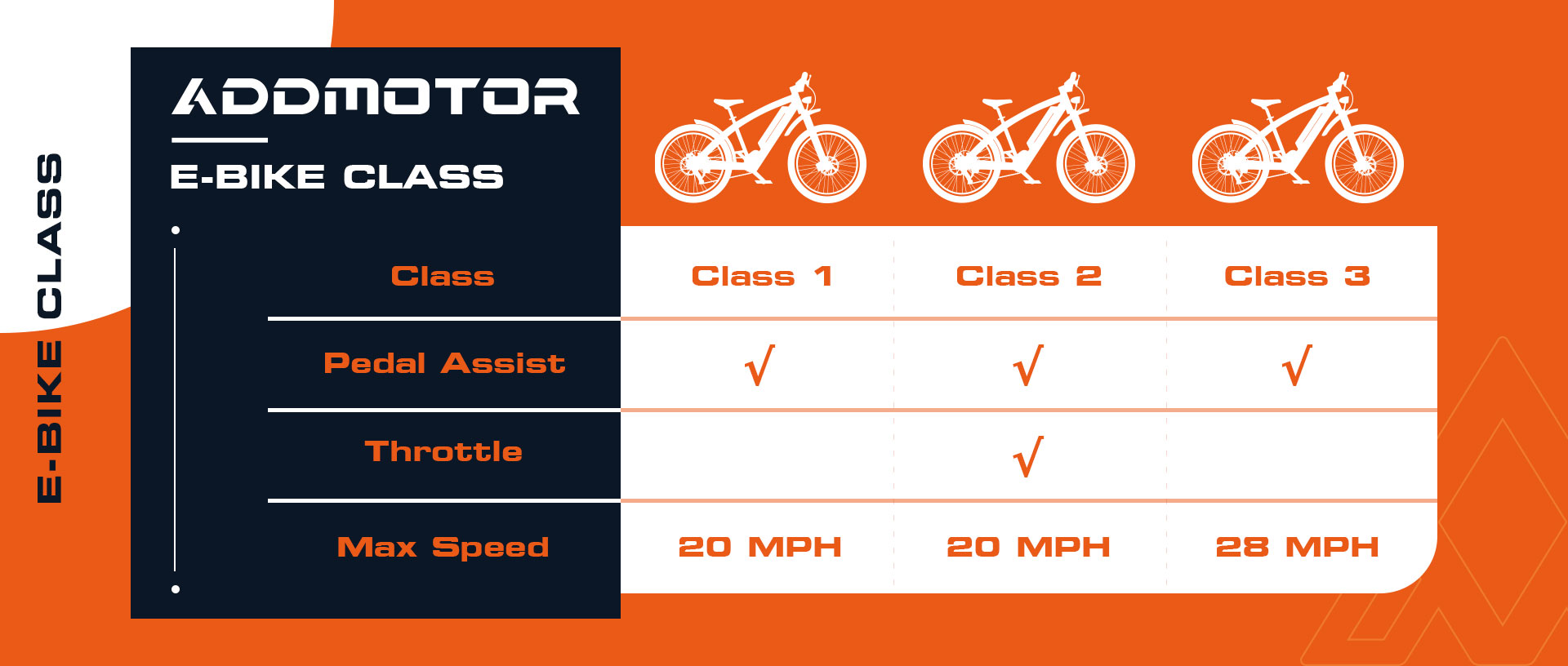
· Class 1 Electric Bike: Electric bikes classified as Class 1 are designed to provide assistance to the rider only when pedaling, with the motor cutting off when the bike reaches 20 mph. These bikes do not have a throttle and rely solely on pedal-assist mode. They are permitted on most multi-use paths, bike lanes, and roads where traditional bicycles are allowed. Class 1 electric bikes are ideal for riders who prefer a traditional biking experience and prioritize compliance with local regulations and trail access rules.
· Class 2 Electric Bike: Class 2 electric bikes are equipped with a motor that can be operated by a throttle, allowing the bike to move without pedaling. They also have a pedal-assist mode that provides motor assistance when the rider pedals. Class 2 electric bikes are limited to a top speed of 20 mph, and the motor assistance can be used without pedaling. They are permitted on most roads, bike lanes, and multi-use paths, although certain areas or trails may have restrictions. Class 2 electric bikes are suitable for riders who desire the convenience of the throttle for easy acceleration without pedaling but still want the option of pedal assist for exercise or longer rides.
· Class 3 Electric Bike: Electric bikes classified as Class 3 are designed to provide assistance only when the rider is pedaling, and the motor assistance cuts off when the bike reaches a speed of 28 mph. These bikes may also have a throttle, but the motor assistance is limited to the pedal-assist mode when the bike exceeds 20 mph. Class 3 electric bikes are typically allowed on roads and bike lanes, although some trails or paths may have restrictions. They are suitable for riders who desire a faster speed and a more performance-oriented riding experience, while still prioritizing compliance with local regulations and safety standards.
It is important to note that the classification of electric bikes may vary by region or country, so it is essential to familiarize yourself with the local laws and regulations regarding electric bikes in your area to ensure compliance and safe riding.
6. Pedal Assist Cadence Sensor vs. Torque Sensor-
Electric bikes can have different types of sensors that determine the level of assistance provided by the motor. The pedal assists cadence sensors to measure the speed at which the rider is pedaling and provide a consistent level of assistance based on the selected assist level. They are more affordable and commonly found in entry-level electric bikes.
On the other hand, torque sensors measure the amount of force applied by the rider on the pedals and provide a more intuitive and natural riding experience. They adjust the level of assistance based on the rider's pedaling effort, making them more responsive and suitable for riders who want a more seamless integration of motor assistance with their pedaling. Torque sensors are typically found in higher-end electric bikes and provide a more sophisticated and performance-oriented riding experience.
7. Step-Over E-Bikes vs. Step-Through Electric Bikes-
The frame design of an electric bike can also impact its accessibility and ease of use. Step-over electric bikes have a traditional diamond-shaped frame that requires riders to swing their leg over the top tube to mount and dismount the bike. They are suitable for riders who are comfortable with a higher standover height and a more traditional biking experience.
The step-through electric bikes have a lower top tube or a completely open frame, allowing riders to easily step through the frame to mount and dismount the bike without having to swing their leg over the top tube. Step-through electric bikes are more accessible and user-friendly, making them suitable for riders who may have limited mobility and flexibility or prefer a more convenient and easy-to-use design.
Considering these factors can help you make a more informed decision when choosing an electric bike that best suits your needs, preferences, and riding style. It's important to thoroughly research and test-ride different options to find the perfect electric bike that will provide you with an enjoyable and efficient riding experience.
8. Types of Electric Bikes-
There are various types of electric bikes available in the market, catering to different riding styles and needs.
· Folding Electric Bikes-
_1684489483.jpg)
_1684490372.jpg)
_1685093443.jpg)
_1685093518.jpg)
_1685093828.jpg)
-(1)_1685093894.jpg)
More Details: Pros and Cons of Adult Electric Trikes
Each type of electric bike caters to specific riding styles, terrains, and needs. It is important to consider your intended use, preferences, and requirements when choosing the right type of electric bike for you. Research, test ride, and consult with experts to make an informed decision that aligns with your riding goals and enhances your overall biking experience.
Conclusion
Finding the best electric bike for you requires careful consideration of your riding intentions, terrain, key features, height, and other factors. Think about how you plan to use the bike, the type of terrain you'll be riding on, the features that matter most to you, your height, and other considerations such as motor type, brakes, class, sensors, and frame style.
Test ride different options, consult with experts and do thorough research to make an informed decision. By taking into account these factors and choosing an electric bike that meets your specific needs, you can enjoy the benefits of electric-assisted cycling and enhance your riding experience. Happy e-biking!

